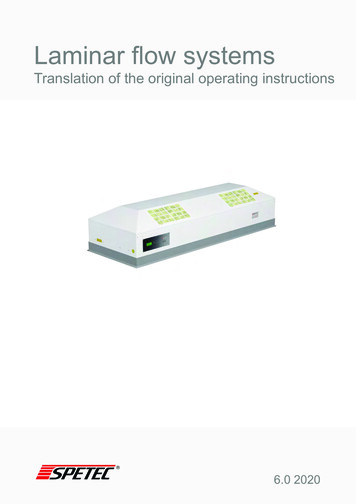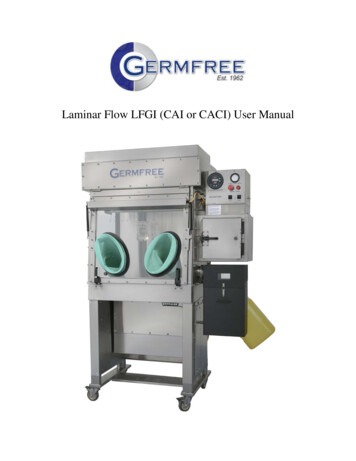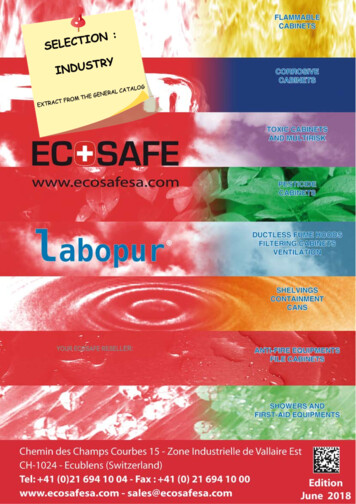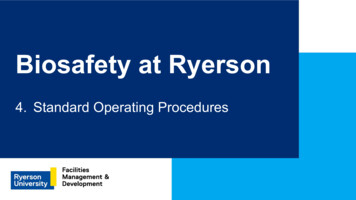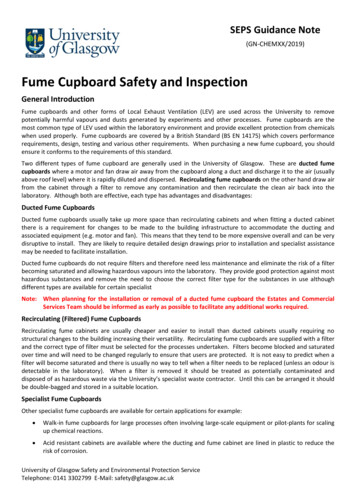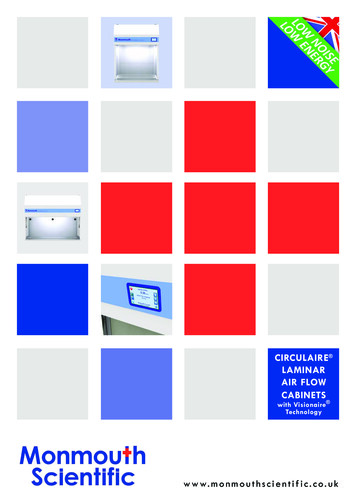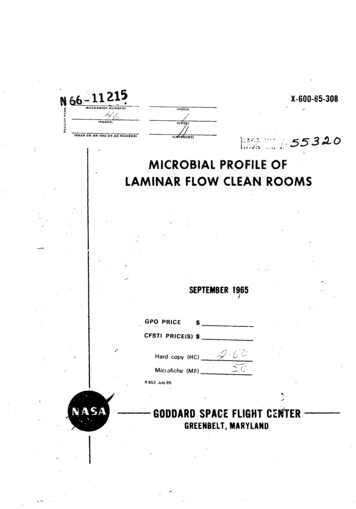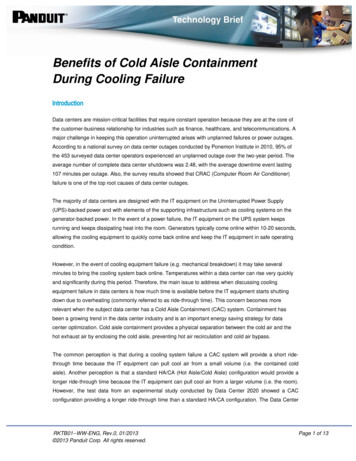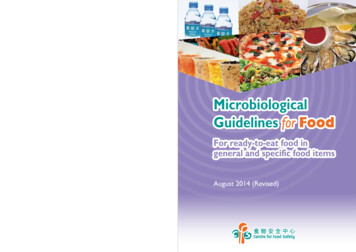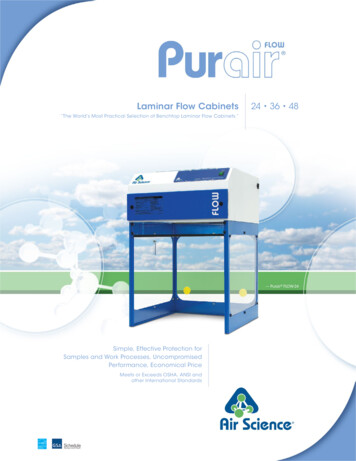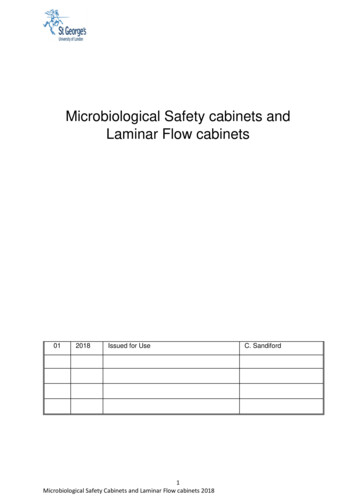
Transcription
Microbiological Safety cabinets andLaminar Flow cabinets012018Issued for Use1Microbiological Safety Cabinets and Laminar Flow cabinets 2018C. Sandiford
IntroductionSeveral types of cabinets can be found in laboratories. Some of the cabinets are designed tooffer protection to the user - microbiological safety cabinets - while some are designed toprimarily protect the items that the person is working on – laminar flow cabinets.Where operator protection against airborne transmitted organisms is priority, amicrobiological safety cabinet should be chosen.High Efficiency Particulate Air (HEPA) FilterHEPA filters are generally designed to capture 99.999% of the material that passes throughthem. HEPA filters are built and certified to the European Standard EN779:2012 and to ISO29463-1:2017Types of Microbiological Safety Cabinets (MSC’s)Microbiological Safety Cabinets are currently manufactured as three classes (I, II and III).While all of the cabinets will provide operator protection, it is important to choose the onethat is most suitable for the process that is being undertaken. The classes of MicrobiologicalSafety Cabinets are different from the biohazard groups listed in the ACDP approved list ofbiological agents. See page 6MSC Class 1This will protect against organisms in ACDP Biohazard Groups 1 - 3.The air is drawn in the front of the cabinet and expelled via the roof mounted HEPA filter.Many cabinets will be fitted with two HEPA filters in line as this gives added protection whenviruses are handled.This type of cabinet will generally keep the worker safe but may not keep samples clean ifthe cabinets are located in an area where there are a large number of airborne particulatesThese cabinets are connected to ducts to vent the excess air to the outside.MSC Class 2This will protect against organisms in ACDP Biohazard Groups 1 - 3.Air is drawn into the cabinet via the front grille and is then drawn up through a HEPA filterbefore being passed downwards over the working surface. The downwards movement of theair produces an air curtain that protects the worker from the material being handled. Wasteair is passed through a HEPA filter. In some machines the mixture ratio may be 30% freshair and 70% HEPA filtered recycled air. As with class 1 cabinets, two HEPA filters may bemounted in line for added protection. The way the air circulates will define a cabinet as typeA1, A2 or A3.These cabinets may be connected to ducts to vent the excess air to external ducts.2Microbiological Safety Cabinets and Laminar Flow cabinets 2018
It should be noted that class 2 cabinets are more susceptible to the airflow being disturbedthan a class 1 microbiological safety cabinet.This type of cabinet may be the optimum choice between worker protection and ease ofhandling the samples and protecting the samples.MSC Class 3This will protect against organisms in ACDP Biohazard Groups 1 - 4. When using thiscabinet all experimental items must be placed into the cabinet prior to work commencing.These cabinets are completely sealed when in operation and HEPA filtered air is drawn intothe cabinet either via fans located on the back or sides of the machines. Samples aremanipulated via rubber gloves that are built into the front panel. Air is not generally recycledin these types of cabinets and is expelled via roof mounted HEPA filters. The machine isgenerally ducted to expel the cabinet air to external ductwork.This type of cabinet offers the worker the greatest level protection provided that the seals arein place and attached.Using Microbiological Safety Cabinets’Daily checksWhen using MSC’s it is important that daily checks are undertaken. If the transmission routeof the organism being handled is via the respiratory route, it is especially important to checkthat the inlet speeds are within the acceptable limits. Records of the daily checks should bekept.The acceptable airflow speeds should be between 0.7 and 0.9 M / S for class I MSC’s and0.6 to 0.9 M / S for Class 2 MSC’s. If the airflow speeds are above or below this range themachine should not be used and the core facilities staff should be contacted to inform themof the problem.Cabinet working environmentIt is important to minimise the number of items in the cabinet so that the airflow is notexcessively disturbed. Class 2 cabinets are particularly sensitive to disturbance of the airflowas the air in the cabinet is a mixture of fresh air taken in via the front grille and recycledHEPA filtered air.If possible, items that generate their own flow or create turbulent airflows should be avoidede.g. microfuges.Care should be taken that loose items such as tissues or other lightweight materials are notsucked up into the fans.Individuals should take care to position themselves correctly at an MSC to avoid backproblems and large scale arm movements that could upset the airflow within the cabinet.This is particularly important when used class 2 MSC’s.3Microbiological Safety Cabinets and Laminar Flow cabinets 2018
Operator Protection Factor (OPF)The level of protection for individuals using MSC’s can be calculated following a KI(Potassium Iodide) Discus test (EN12469:2000) where a solution of Potassium Iodide issprayed into the cabinet while it is operating and the number of particles that emerge in agiven period are counted. In most tests an artificial item that represents a human arm ispresent in the cabinet. The lower the number of particles that escape from the front of thecabinet the higher the operator protection factor. If only 1 out of 100,000 particles wasreleased into the atmosphere this would give an OPF of 105, if only 1 particle out of1,000,000 is released then the OPF will be 106.It is important to note that the level of protection can be reduced if the cabinet is full ofobjects such as discard pots, racks, bio-bins, sharps bins and the rate of the airflow acrossthe front is lowered.It is important that a KI test is performed after moving the MSC, or introducing bulkyequipment into a MSC as this may affect the airflow. If the lab is being rearranged by theintroduction of other large equipment or another MSC, the cabinet should also be retested asthese items may affect the airflow. It is normally recommended that if a second MSC will beplaced directly opposite an existing machine, a space of at least 2.0M is present to preventthe airflows overlapping and fighting with each other.TrainingIndividuals must be trained in how to use the MSC’s. While equipment may look similar,there may be variations in the start-up and shut-down cycles and in the meaning of thewarning lights. Individuals must be informed of the minimum and maximum airflow rates thatwill provide adequate worker protection.The training should be undertaken by the Principal Investigator (PI) prior to the individualstarting work and the records must be kept by them. If the PI is not available then a memberof the core facilities staff may be approached to be provide training. The Senior LaboratoryManager should be contacted in the first instance.A prototype training record would discuss1Removal of the night door including the switching off of the UV light if present.2.Meaning of the various switches on the front panel.3.Starting the cabinet4.Stabilisation of the airflow and measurement of the airflow.5.Meaning of the alarms and when it is safe to start work6.How to work in the cabinet including dealing with waste7.Dealing with failures in airflow during work8.Cleaning the cabinet after work9.Closing the cabinet.4Microbiological Safety Cabinets and Laminar Flow cabinets 2018
Some of the MSC’s in SGUL have powered doors and how to deal with a failure of themechanism should be discussed with the worker.Use of cabinetsThe cabinet should be chosen on the risk that the organism being handled poses to anindividual. People who are pregnant or immunocompromised or under medical treatmentmay require additional protection.The use of a microbiological safety cabinet will not make up for poor laboratory practice as itis possible to perturb the airflow of both class 1 and class 2 cabinets.An MSC is not always required when handling HG1 or HG2 organisms. A risk assessmentshould identify the need for MSC use e.g. Neisseria gonorrhoeae can be handled on theopen bench while wearing the correct PPE and using good aseptic technique and goodlaboratory practice as it is not transmitted by the respiratory / airborne route. Neisseriameningitidis should be handled in a MSC while using good aseptic technique and goodlaboratory practice as it is transmitted by the respiratory / airborne route.It is important that organisms whose primary route of transmission is via droplet / inhalation /respiratory routes e.g. Neisseria meningitidis, Streptococcus pneumoniae or Mycobacteriumtuberculosis are handled in a microbiological safety cabinet.All HG3 organisms should be in Class I cabinets unless a Risk Assessment argues that it isnot necessary e.g. not aerosol transmission route.Microbiological safety cabinets can also be used to provide protection for work involvingtissue culture or preparation of samples for proteomic or genomic analysis that require asterile environment. Good laboratory practice should always be followed when undertakingany type of work to minimise the chances of contamination.The cabinet selected for the work and the reason for its use must be mentioned in theproject COSHH assessment.Cabinets must never be used with the front panel raised as this would pose a risk not only tothe operator but also to other individuals that are in the area.CleaningThe insides of microbiological safety cabinets must always be cleaned at the end of eachworking session. The cleaning agent selected must not corrode any of the surfaces of thecabinet.Some cabinets may have a single removable panel or several removable panels as theworking surface, the panels must always be lifted up and the base surface cleaned at theend of each session to avoid organisms growing in any spilt media or other fluid.The cabinet manual should be checked before Virkon or other halide containing agents areused as a cleaning agent as halides may damage the surface finish either by causing thepaint to corrode or by causing the bare metal to become pitted. While the damage may notbe immediately visible to the eye, it can affect the airflow within the cabinet and lead to areduction in operator protection.5Microbiological Safety Cabinets and Laminar Flow cabinets 2018
If 70% Ethanol is to be used as the cleaning agent, it must be confirmed that this will cause a106 reduction in the numbers of the organism that was being handled.FumigationIn exceptional circumstances, a MSC may need to be fumigated. If you believe that thecabinet has become contaminated and requires fumigation this should be discussed with thecore facilities team.It is very rare for a cabinet that has only been used for tissue culture or to preserve thecleanliness of proteomic or genomic samples to require fumigation.ServicingThe servicing of the cabinets will normally be arranged by the core facilities staff. All cabinetsthat are used to handle biohazard group 3 pathogens or GMO must be serviced every 6months. Class 2 MSC’s are also serviced every six months.Laminar flow cabinetsThese cabinets are designed to protect the sample and not the worker.It is important to note that many laminar flow cabinets look similar to microbiological safetycabinets and the correct cabinet must be used. These cabinets must never be used tohandle micro-organisms that pose an infection risk and whose route of transmission isairborneIn a laminar flow cabinet air is drawn in via a top mounted fan and is blown through a HighEfficiency Particulate Air (HEPA) Filter and then down into the cabinet to be expelled out viathe front panel. The air flow can be vertical or horizontal until the moment that the air exitsthe cabinet. The cabinet is run at a positive pressure to the ambient room air to ensure thatroom air does enter the working surface and contaminate the environment.It is important to note that the air expelled from the cabinet may enter the workers respiratoryzone so correct posture is important.The associated standard is BS EN ISO 14664-1 for cleanrooms and associated controlledenvironments.Biohazard GroupsThe ACDP biohazard groups are1.Bio agents unlikely to cause disease6Microbiological Safety Cabinets and Laminar Flow cabinets 2018
2.May cause disease but a low hazard with the spread of disease unlikely and withprophylaxis/treatment available. Several lethal infections that are spread by theairborne route are biohazard group 2 e.g. Legionella pneumophila or N. meningitidis.3Possibility of a severe disease with spread of disease possible althoughprophylaxis/treatment is available.4.Causes severe disease with serious bio-hazard risk and a high risk of spread ofdisease. With prophylaxis/treatment not normally available this is the most seriousbio-hazard risk groupMore information on Biohazard groups is available hereFurther informationBritish Standard BS EN 12469:2000. Biotechnology: Performance criteria for microbiologicalsafety cabinets.British Standard BS 5726:2005.Microbiological safety cabinets: Information to be supplied by the purchaser to the vendorand to the installer, and siting and use of cabinets.The Management, design and operation of microbiological containment laboratories, Healthand Safety Commission/ Department of Health, Advisory Committee on DangerousPathogens.Training VideosA variety of good videos giving information on the use of MSC’s is available on YouTube.These videos are not a substitute for being talked through the nuances of the machine youwill use.Microbiological Safety Cabinets are sometimes known as Biological Safety Cabinets (BSC).Lam Systems Microbiological Safety CabinetsNational Institutes of Health BSC How it works to Protect you.Monmouth Scientific Microbiological Safety Cabinet Class 27Microbiological Safety Cabinets and Laminar Flow cabinets 2018
Working safely in a class 2 cabinetUse of a Class 1 cabinet8Microbiological Safety Cabinets and Laminar Flow cabinets 2018
Microbiological Safety Cabinets and Laminar Flow cabinets 2018 It should be noted that class 2 cabinets are more susceptible to the airflow being disturbed than a class 1 microbiological safety cabinet. This type of cabinet may be the optimum choice between worker protection and ease of handling the samples and protecting the samples. MSC Class 3
